Leadership Styles and Change Implementation at Xerox
VerifiedAdded on 2023/06/11
|12
|3252
|475
AI Summary
This report discusses the leadership styles at Xerox, the difference between radical and incremental change processes, and the implementation of change at Xerox. It also covers the barriers faced and the framework used for affecting change. Subject: Business Management, Course Code: BMGT101, College/University: X University.
Contribute Materials
Your contribution can guide someone’s learning journey. Share your
documents today.
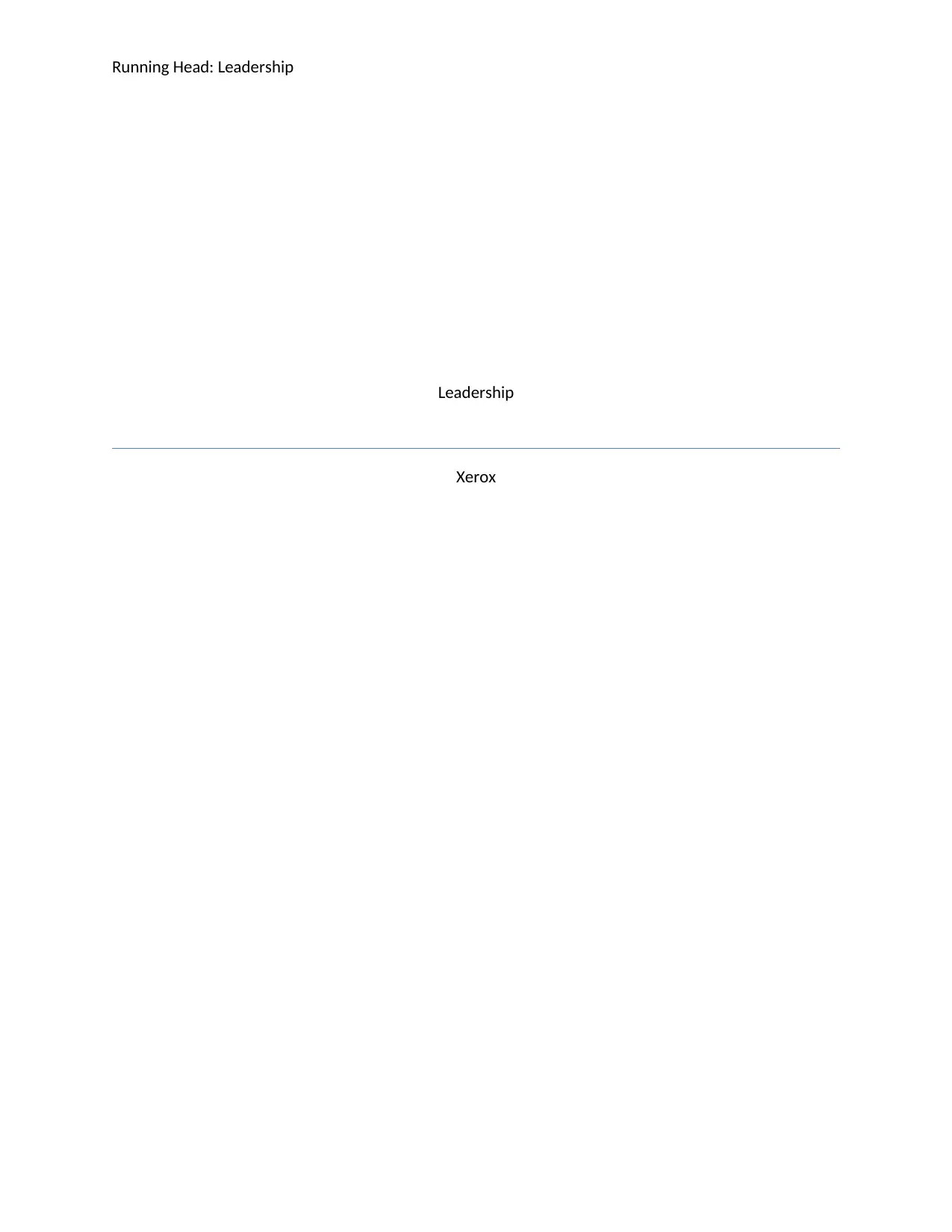
Running Head: Leadership
Leadership
Xerox
Leadership
Xerox
Secure Best Marks with AI Grader
Need help grading? Try our AI Grader for instant feedback on your assignments.

1
Leadership
Contents
Introduction.................................................................................................................................................2
Leadership Styles at Xerox..........................................................................................................................2
Difference between Radical and Incremental Change Processes.................................................................4
Incremental innovation........................................................................................................................4
Radical innovation...................................................................................................................................5
Implementation of change in Xerox........................................................................................................6
Barriers to Implementation at Xerox...........................................................................................................7
Framework Mulcahy Used for Affecting Change........................................................................................7
Conclusion...................................................................................................................................................8
References...................................................................................................................................................9
Leadership
Contents
Introduction.................................................................................................................................................2
Leadership Styles at Xerox..........................................................................................................................2
Difference between Radical and Incremental Change Processes.................................................................4
Incremental innovation........................................................................................................................4
Radical innovation...................................................................................................................................5
Implementation of change in Xerox........................................................................................................6
Barriers to Implementation at Xerox...........................................................................................................7
Framework Mulcahy Used for Affecting Change........................................................................................7
Conclusion...................................................................................................................................................8
References...................................................................................................................................................9
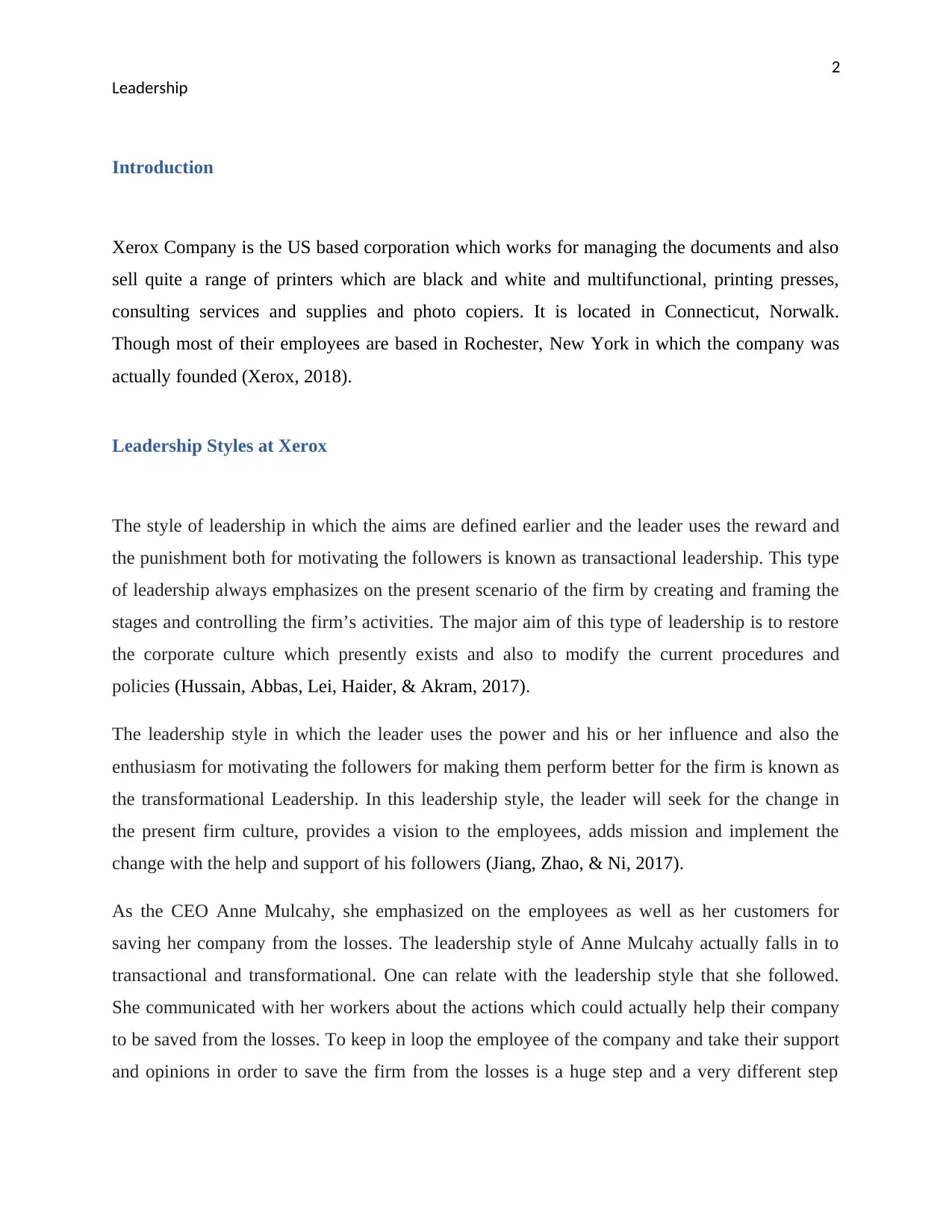
2
Leadership
Introduction
Xerox Company is the US based corporation which works for managing the documents and also
sell quite a range of printers which are black and white and multifunctional, printing presses,
consulting services and supplies and photo copiers. It is located in Connecticut, Norwalk.
Though most of their employees are based in Rochester, New York in which the company was
actually founded (Xerox, 2018).
Leadership Styles at Xerox
The style of leadership in which the aims are defined earlier and the leader uses the reward and
the punishment both for motivating the followers is known as transactional leadership. This type
of leadership always emphasizes on the present scenario of the firm by creating and framing the
stages and controlling the firm’s activities. The major aim of this type of leadership is to restore
the corporate culture which presently exists and also to modify the current procedures and
policies (Hussain, Abbas, Lei, Haider, & Akram, 2017).
The leadership style in which the leader uses the power and his or her influence and also the
enthusiasm for motivating the followers for making them perform better for the firm is known as
the transformational Leadership. In this leadership style, the leader will seek for the change in
the present firm culture, provides a vision to the employees, adds mission and implement the
change with the help and support of his followers (Jiang, Zhao, & Ni, 2017).
As the CEO Anne Mulcahy, she emphasized on the employees as well as her customers for
saving her company from the losses. The leadership style of Anne Mulcahy actually falls in to
transactional and transformational. One can relate with the leadership style that she followed.
She communicated with her workers about the actions which could actually help their company
to be saved from the losses. To keep in loop the employee of the company and take their support
and opinions in order to save the firm from the losses is a huge step and a very different step
Leadership
Introduction
Xerox Company is the US based corporation which works for managing the documents and also
sell quite a range of printers which are black and white and multifunctional, printing presses,
consulting services and supplies and photo copiers. It is located in Connecticut, Norwalk.
Though most of their employees are based in Rochester, New York in which the company was
actually founded (Xerox, 2018).
Leadership Styles at Xerox
The style of leadership in which the aims are defined earlier and the leader uses the reward and
the punishment both for motivating the followers is known as transactional leadership. This type
of leadership always emphasizes on the present scenario of the firm by creating and framing the
stages and controlling the firm’s activities. The major aim of this type of leadership is to restore
the corporate culture which presently exists and also to modify the current procedures and
policies (Hussain, Abbas, Lei, Haider, & Akram, 2017).
The leadership style in which the leader uses the power and his or her influence and also the
enthusiasm for motivating the followers for making them perform better for the firm is known as
the transformational Leadership. In this leadership style, the leader will seek for the change in
the present firm culture, provides a vision to the employees, adds mission and implement the
change with the help and support of his followers (Jiang, Zhao, & Ni, 2017).
As the CEO Anne Mulcahy, she emphasized on the employees as well as her customers for
saving her company from the losses. The leadership style of Anne Mulcahy actually falls in to
transactional and transformational. One can relate with the leadership style that she followed.
She communicated with her workers about the actions which could actually help their company
to be saved from the losses. To keep in loop the employee of the company and take their support
and opinions in order to save the firm from the losses is a huge step and a very different step

3
Leadership
which a company or the CEO of the company ca take. This seems more like a transformational
style she followed.
According to Kellerman (1984), the leaders who follow transactional leadership style brings their
subordinates in to a relation who bonds leader and the follower and then the contributions are
there from both the sides together with acknowledgement and the rewards. Now the transactional
leader who is effective should fulfill the expectations of their subordinates as they are influential
and have the power (Sarros & Cooper, 2006). In case of Anne, she actually met the top 100
executives for gaining the support from the team of leadership and she asked them as to if they
are willing to commit themselves and the result of that was that 98 of those 100 leaders were
happy to stay. In the year 1986, Graen, Liden and Hoel also can support this act. All three found
that the employee who are linked in the relationships which includes support and the emotional
exchange of both qualities high and low were most likely to leave the firm. While there was
crisis in the firm, Anne spent approximately 90 days in the airplanes for visiting different offices
just to listen to the employees and the customer’s perspectives about the firm. This shows the
active management dimension by exception when Anne took corrective actions that involved the
employees and the focus of the customer for getting the company to return to its normal
profitability (Heuvel, 2010).
Transformational Leadership emphasizes on the dimensions like Charisma, Inspiration,
Intellectual Stimulation and individual consideration. In case of the leadership style followed at
Xerox by Anne, there are some of the dimensions which explain the leadership style of Anne
towards her employees which is all the dimensions like charisma, inspiration, intellectual
simulation and consideration of the individual. Charisma will always give the mission and the
vision in which the leader brings pride with respect and trust. This happened when Anne thought
that her turnaround plan for the company was very aggressive and of this would work or not as
her employees also did not question her at all with respect to the plan she had in mind. Rather
than going skeptical, she outlined the new vision for the company for it to become the reality.
The result of this action was that they were able to achieve approximately 80% of the target they
has in mind (Bryant, 2003).
Leadership
which a company or the CEO of the company ca take. This seems more like a transformational
style she followed.
According to Kellerman (1984), the leaders who follow transactional leadership style brings their
subordinates in to a relation who bonds leader and the follower and then the contributions are
there from both the sides together with acknowledgement and the rewards. Now the transactional
leader who is effective should fulfill the expectations of their subordinates as they are influential
and have the power (Sarros & Cooper, 2006). In case of Anne, she actually met the top 100
executives for gaining the support from the team of leadership and she asked them as to if they
are willing to commit themselves and the result of that was that 98 of those 100 leaders were
happy to stay. In the year 1986, Graen, Liden and Hoel also can support this act. All three found
that the employee who are linked in the relationships which includes support and the emotional
exchange of both qualities high and low were most likely to leave the firm. While there was
crisis in the firm, Anne spent approximately 90 days in the airplanes for visiting different offices
just to listen to the employees and the customer’s perspectives about the firm. This shows the
active management dimension by exception when Anne took corrective actions that involved the
employees and the focus of the customer for getting the company to return to its normal
profitability (Heuvel, 2010).
Transformational Leadership emphasizes on the dimensions like Charisma, Inspiration,
Intellectual Stimulation and individual consideration. In case of the leadership style followed at
Xerox by Anne, there are some of the dimensions which explain the leadership style of Anne
towards her employees which is all the dimensions like charisma, inspiration, intellectual
simulation and consideration of the individual. Charisma will always give the mission and the
vision in which the leader brings pride with respect and trust. This happened when Anne thought
that her turnaround plan for the company was very aggressive and of this would work or not as
her employees also did not question her at all with respect to the plan she had in mind. Rather
than going skeptical, she outlined the new vision for the company for it to become the reality.
The result of this action was that they were able to achieve approximately 80% of the target they
has in mind (Bryant, 2003).
Secure Best Marks with AI Grader
Need help grading? Try our AI Grader for instant feedback on your assignments.
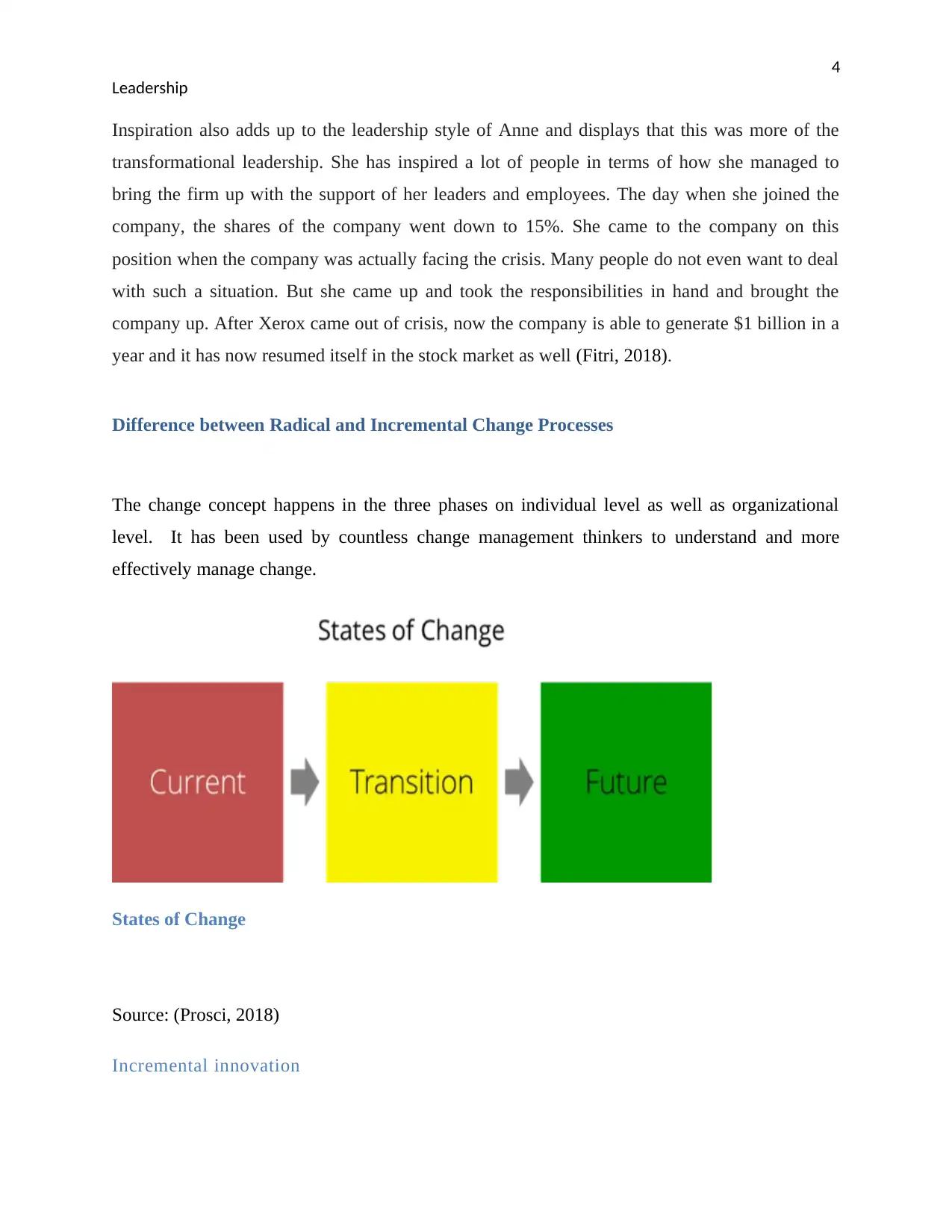
4
Leadership
Inspiration also adds up to the leadership style of Anne and displays that this was more of the
transformational leadership. She has inspired a lot of people in terms of how she managed to
bring the firm up with the support of her leaders and employees. The day when she joined the
company, the shares of the company went down to 15%. She came to the company on this
position when the company was actually facing the crisis. Many people do not even want to deal
with such a situation. But she came up and took the responsibilities in hand and brought the
company up. After Xerox came out of crisis, now the company is able to generate $1 billion in a
year and it has now resumed itself in the stock market as well (Fitri, 2018).
Difference between Radical and Incremental Change Processes
The change concept happens in the three phases on individual level as well as organizational
level. It has been used by countless change management thinkers to understand and more
effectively manage change.
States of Change
Source: (Prosci, 2018)
Incremental innovation
Leadership
Inspiration also adds up to the leadership style of Anne and displays that this was more of the
transformational leadership. She has inspired a lot of people in terms of how she managed to
bring the firm up with the support of her leaders and employees. The day when she joined the
company, the shares of the company went down to 15%. She came to the company on this
position when the company was actually facing the crisis. Many people do not even want to deal
with such a situation. But she came up and took the responsibilities in hand and brought the
company up. After Xerox came out of crisis, now the company is able to generate $1 billion in a
year and it has now resumed itself in the stock market as well (Fitri, 2018).
Difference between Radical and Incremental Change Processes
The change concept happens in the three phases on individual level as well as organizational
level. It has been used by countless change management thinkers to understand and more
effectively manage change.
States of Change
Source: (Prosci, 2018)
Incremental innovation

5
Leadership
This is a very common approach in most of the firm which are already established and focus on
the creation of the new products and services while having some of the goals in mind (Sen &
Ghandforoush, 2011). The goals are:
Growth of sales and the profit should exist for the current products and services.
The protection of the present models of business.
Creation and development of the new business models but not be cannibalizing the
present ones.
This approach is well known as the approach which reduces the risk which radical innovation
usually takes. This approach has the advantages for the companies which have great capital of
humans and the resources and for the firm for whom it is easy to follow the path of innovation.
The advantages those they bring are:
It helps the firms to stay in the competition. At the same time, they are profiting from the
product and at the same time they are also creating a new generation of the product.
The ideas are very easy to be sold. When the customers are habitual with a particular type
of the product or the service, they find it easy in understanding and buying of the new
improvements (Engen & Holen, 2014).
They are affordable. The process of the development is not impossible when the firm
possess all the capital and infrastructure required for keeping the innovation continuous
on the similar products and services.
Radical innovation
This innovation is on the more complicated side to achieve. The whole process of this is complex
instead of the discrete event and it implies a tough, long and risky process. It can be defined in a
few ways but it will be apt to describe it as the blue ocean strategy (Sood & Tellis, 2006).
The blue ocean strategy means that the firm would never fight for the slice of the market cake.
Instead of that, this develops new market while at the same time stepping aside of the crowd.
This approach also has some advantages. They are:
Leadership
This is a very common approach in most of the firm which are already established and focus on
the creation of the new products and services while having some of the goals in mind (Sen &
Ghandforoush, 2011). The goals are:
Growth of sales and the profit should exist for the current products and services.
The protection of the present models of business.
Creation and development of the new business models but not be cannibalizing the
present ones.
This approach is well known as the approach which reduces the risk which radical innovation
usually takes. This approach has the advantages for the companies which have great capital of
humans and the resources and for the firm for whom it is easy to follow the path of innovation.
The advantages those they bring are:
It helps the firms to stay in the competition. At the same time, they are profiting from the
product and at the same time they are also creating a new generation of the product.
The ideas are very easy to be sold. When the customers are habitual with a particular type
of the product or the service, they find it easy in understanding and buying of the new
improvements (Engen & Holen, 2014).
They are affordable. The process of the development is not impossible when the firm
possess all the capital and infrastructure required for keeping the innovation continuous
on the similar products and services.
Radical innovation
This innovation is on the more complicated side to achieve. The whole process of this is complex
instead of the discrete event and it implies a tough, long and risky process. It can be defined in a
few ways but it will be apt to describe it as the blue ocean strategy (Sood & Tellis, 2006).
The blue ocean strategy means that the firm would never fight for the slice of the market cake.
Instead of that, this develops new market while at the same time stepping aside of the crowd.
This approach also has some advantages. They are:

6
Leadership
It will always provide the opportunity to get a great win as long as the inventor is the
pioneer in the domain and has no competition in the market. This is a very important
advantage for any firm as they will be the only ones in the market then.
During the first stages of any firm, if the firm does not have any competitor, it will
provide the market a chance to grow a lot in a easy way. The firm then can set its own
rules and pricing in order to rule the market because the customers do not have anything
else to compare to (Audretsch & Aldridge, 2014).
The markets which are new are always open for the further development and the
innovation. Once the new ones are created the options for the further innovations are high
mostly. This means that the capturing value will be easy as compared to in mature
markets.
However, developing new Blue Ocean is not simple, rather, it is a little unsafe.
Timing should be perfect, in order to deliver brand new product to the right people
at the right time. Slow market adoption is a clear possibility, hindering market
growth, and the investment needed is usually quite big, without clear return
perspectives.
Implementation of change in Xerox
Xerox began with the implementation of competitive benchmarking as this was the apt way to
utilize the best practices in the firm as in many of the copier firms the processes and the
operations were not being practiced. For tackling this Xerox followed these steps:
1. They standardized most of the parts that supported them in reducing the number of the
vendors for the copier business from 5000 to 400.
2. The incepted a certification process in which the suppliers were given training or given
feedback as to where and what they lacked in their processes.
3. Vendors were asked for their ideas for even better designs and also for the improvement in the
services given to the customers.
Leadership
It will always provide the opportunity to get a great win as long as the inventor is the
pioneer in the domain and has no competition in the market. This is a very important
advantage for any firm as they will be the only ones in the market then.
During the first stages of any firm, if the firm does not have any competitor, it will
provide the market a chance to grow a lot in a easy way. The firm then can set its own
rules and pricing in order to rule the market because the customers do not have anything
else to compare to (Audretsch & Aldridge, 2014).
The markets which are new are always open for the further development and the
innovation. Once the new ones are created the options for the further innovations are high
mostly. This means that the capturing value will be easy as compared to in mature
markets.
However, developing new Blue Ocean is not simple, rather, it is a little unsafe.
Timing should be perfect, in order to deliver brand new product to the right people
at the right time. Slow market adoption is a clear possibility, hindering market
growth, and the investment needed is usually quite big, without clear return
perspectives.
Implementation of change in Xerox
Xerox began with the implementation of competitive benchmarking as this was the apt way to
utilize the best practices in the firm as in many of the copier firms the processes and the
operations were not being practiced. For tackling this Xerox followed these steps:
1. They standardized most of the parts that supported them in reducing the number of the
vendors for the copier business from 5000 to 400.
2. The incepted a certification process in which the suppliers were given training or given
feedback as to where and what they lacked in their processes.
3. Vendors were asked for their ideas for even better designs and also for the improvement in the
services given to the customers.
Paraphrase This Document
Need a fresh take? Get an instant paraphrase of this document with our AI Paraphraser
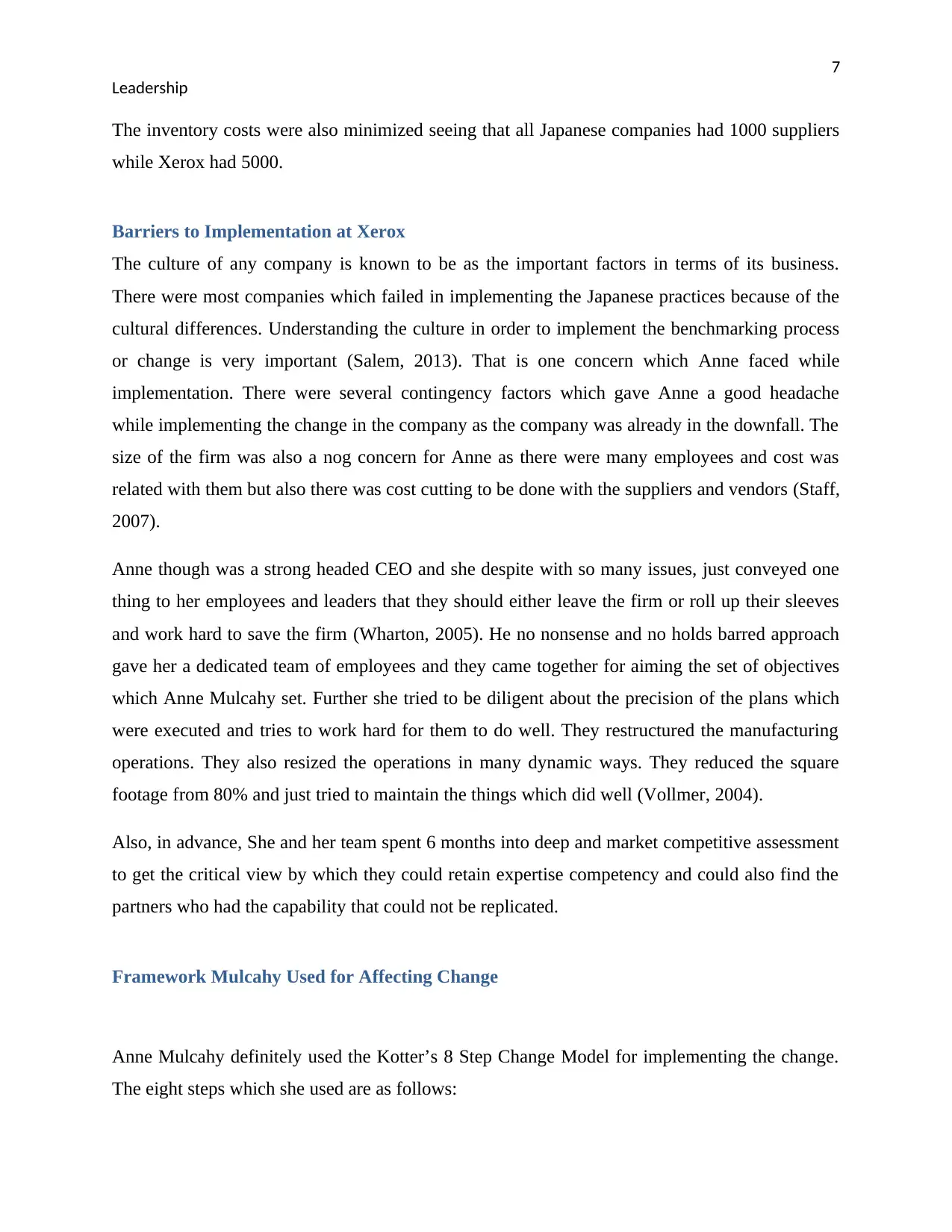
7
Leadership
The inventory costs were also minimized seeing that all Japanese companies had 1000 suppliers
while Xerox had 5000.
Barriers to Implementation at Xerox
The culture of any company is known to be as the important factors in terms of its business.
There were most companies which failed in implementing the Japanese practices because of the
cultural differences. Understanding the culture in order to implement the benchmarking process
or change is very important (Salem, 2013). That is one concern which Anne faced while
implementation. There were several contingency factors which gave Anne a good headache
while implementing the change in the company as the company was already in the downfall. The
size of the firm was also a nog concern for Anne as there were many employees and cost was
related with them but also there was cost cutting to be done with the suppliers and vendors (Staff,
2007).
Anne though was a strong headed CEO and she despite with so many issues, just conveyed one
thing to her employees and leaders that they should either leave the firm or roll up their sleeves
and work hard to save the firm (Wharton, 2005). He no nonsense and no holds barred approach
gave her a dedicated team of employees and they came together for aiming the set of objectives
which Anne Mulcahy set. Further she tried to be diligent about the precision of the plans which
were executed and tries to work hard for them to do well. They restructured the manufacturing
operations. They also resized the operations in many dynamic ways. They reduced the square
footage from 80% and just tried to maintain the things which did well (Vollmer, 2004).
Also, in advance, She and her team spent 6 months into deep and market competitive assessment
to get the critical view by which they could retain expertise competency and could also find the
partners who had the capability that could not be replicated.
Framework Mulcahy Used for Affecting Change
Anne Mulcahy definitely used the Kotter’s 8 Step Change Model for implementing the change.
The eight steps which she used are as follows:
Leadership
The inventory costs were also minimized seeing that all Japanese companies had 1000 suppliers
while Xerox had 5000.
Barriers to Implementation at Xerox
The culture of any company is known to be as the important factors in terms of its business.
There were most companies which failed in implementing the Japanese practices because of the
cultural differences. Understanding the culture in order to implement the benchmarking process
or change is very important (Salem, 2013). That is one concern which Anne faced while
implementation. There were several contingency factors which gave Anne a good headache
while implementing the change in the company as the company was already in the downfall. The
size of the firm was also a nog concern for Anne as there were many employees and cost was
related with them but also there was cost cutting to be done with the suppliers and vendors (Staff,
2007).
Anne though was a strong headed CEO and she despite with so many issues, just conveyed one
thing to her employees and leaders that they should either leave the firm or roll up their sleeves
and work hard to save the firm (Wharton, 2005). He no nonsense and no holds barred approach
gave her a dedicated team of employees and they came together for aiming the set of objectives
which Anne Mulcahy set. Further she tried to be diligent about the precision of the plans which
were executed and tries to work hard for them to do well. They restructured the manufacturing
operations. They also resized the operations in many dynamic ways. They reduced the square
footage from 80% and just tried to maintain the things which did well (Vollmer, 2004).
Also, in advance, She and her team spent 6 months into deep and market competitive assessment
to get the critical view by which they could retain expertise competency and could also find the
partners who had the capability that could not be replicated.
Framework Mulcahy Used for Affecting Change
Anne Mulcahy definitely used the Kotter’s 8 Step Change Model for implementing the change.
The eight steps which she used are as follows:
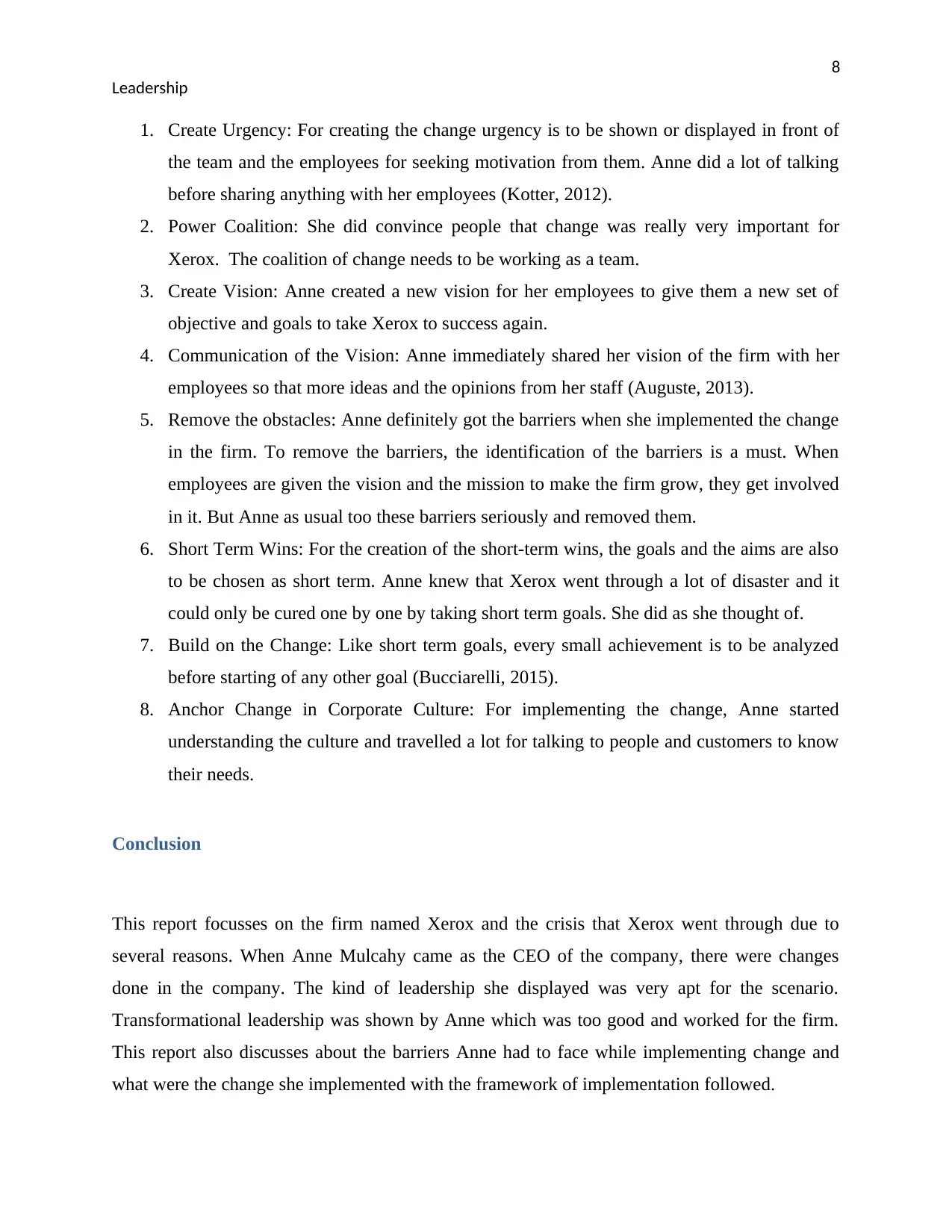
8
Leadership
1. Create Urgency: For creating the change urgency is to be shown or displayed in front of
the team and the employees for seeking motivation from them. Anne did a lot of talking
before sharing anything with her employees (Kotter, 2012).
2. Power Coalition: She did convince people that change was really very important for
Xerox. The coalition of change needs to be working as a team.
3. Create Vision: Anne created a new vision for her employees to give them a new set of
objective and goals to take Xerox to success again.
4. Communication of the Vision: Anne immediately shared her vision of the firm with her
employees so that more ideas and the opinions from her staff (Auguste, 2013).
5. Remove the obstacles: Anne definitely got the barriers when she implemented the change
in the firm. To remove the barriers, the identification of the barriers is a must. When
employees are given the vision and the mission to make the firm grow, they get involved
in it. But Anne as usual too these barriers seriously and removed them.
6. Short Term Wins: For the creation of the short-term wins, the goals and the aims are also
to be chosen as short term. Anne knew that Xerox went through a lot of disaster and it
could only be cured one by one by taking short term goals. She did as she thought of.
7. Build on the Change: Like short term goals, every small achievement is to be analyzed
before starting of any other goal (Bucciarelli, 2015).
8. Anchor Change in Corporate Culture: For implementing the change, Anne started
understanding the culture and travelled a lot for talking to people and customers to know
their needs.
Conclusion
This report focusses on the firm named Xerox and the crisis that Xerox went through due to
several reasons. When Anne Mulcahy came as the CEO of the company, there were changes
done in the company. The kind of leadership she displayed was very apt for the scenario.
Transformational leadership was shown by Anne which was too good and worked for the firm.
This report also discusses about the barriers Anne had to face while implementing change and
what were the change she implemented with the framework of implementation followed.
Leadership
1. Create Urgency: For creating the change urgency is to be shown or displayed in front of
the team and the employees for seeking motivation from them. Anne did a lot of talking
before sharing anything with her employees (Kotter, 2012).
2. Power Coalition: She did convince people that change was really very important for
Xerox. The coalition of change needs to be working as a team.
3. Create Vision: Anne created a new vision for her employees to give them a new set of
objective and goals to take Xerox to success again.
4. Communication of the Vision: Anne immediately shared her vision of the firm with her
employees so that more ideas and the opinions from her staff (Auguste, 2013).
5. Remove the obstacles: Anne definitely got the barriers when she implemented the change
in the firm. To remove the barriers, the identification of the barriers is a must. When
employees are given the vision and the mission to make the firm grow, they get involved
in it. But Anne as usual too these barriers seriously and removed them.
6. Short Term Wins: For the creation of the short-term wins, the goals and the aims are also
to be chosen as short term. Anne knew that Xerox went through a lot of disaster and it
could only be cured one by one by taking short term goals. She did as she thought of.
7. Build on the Change: Like short term goals, every small achievement is to be analyzed
before starting of any other goal (Bucciarelli, 2015).
8. Anchor Change in Corporate Culture: For implementing the change, Anne started
understanding the culture and travelled a lot for talking to people and customers to know
their needs.
Conclusion
This report focusses on the firm named Xerox and the crisis that Xerox went through due to
several reasons. When Anne Mulcahy came as the CEO of the company, there were changes
done in the company. The kind of leadership she displayed was very apt for the scenario.
Transformational leadership was shown by Anne which was too good and worked for the firm.
This report also discusses about the barriers Anne had to face while implementing change and
what were the change she implemented with the framework of implementation followed.

9
Leadership
Leadership
Secure Best Marks with AI Grader
Need help grading? Try our AI Grader for instant feedback on your assignments.
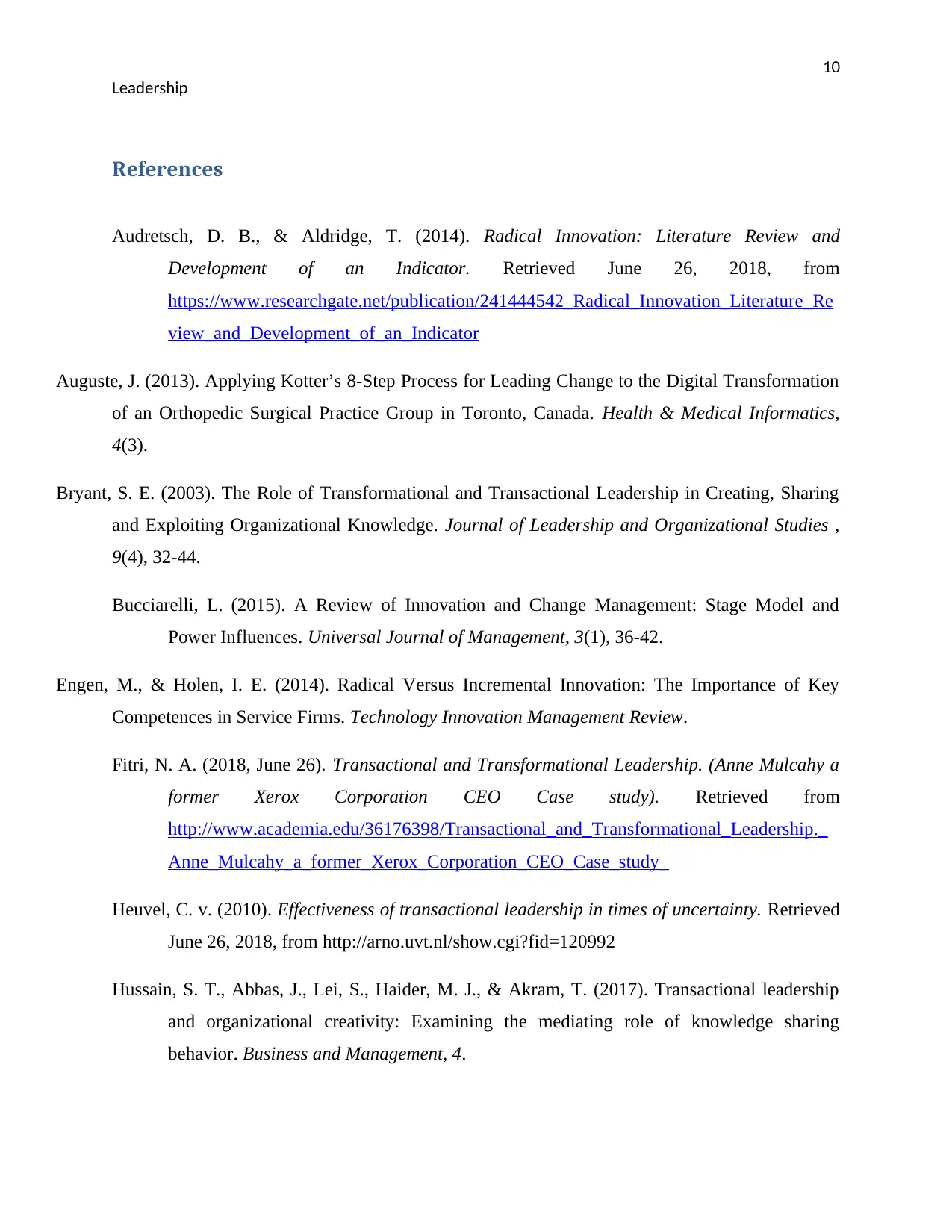
10
Leadership
References
Audretsch, D. B., & Aldridge, T. (2014). Radical Innovation: Literature Review and
Development of an Indicator. Retrieved June 26, 2018, from
https://www.researchgate.net/publication/241444542_Radical_Innovation_Literature_Re
view_and_Development_of_an_Indicator
Auguste, J. (2013). Applying Kotter’s 8-Step Process for Leading Change to the Digital Transformation
of an Orthopedic Surgical Practice Group in Toronto, Canada. Health & Medical Informatics,
4(3).
Bryant, S. E. (2003). The Role of Transformational and Transactional Leadership in Creating, Sharing
and Exploiting Organizational Knowledge. Journal of Leadership and Organizational Studies ,
9(4), 32-44.
Bucciarelli, L. (2015). A Review of Innovation and Change Management: Stage Model and
Power Influences. Universal Journal of Management, 3(1), 36-42.
Engen, M., & Holen, I. E. (2014). Radical Versus Incremental Innovation: The Importance of Key
Competences in Service Firms. Technology Innovation Management Review.
Fitri, N. A. (2018, June 26). Transactional and Transformational Leadership. (Anne Mulcahy a
former Xerox Corporation CEO Case study). Retrieved from
http://www.academia.edu/36176398/Transactional_and_Transformational_Leadership._
Anne_Mulcahy_a_former_Xerox_Corporation_CEO_Case_study_
Heuvel, C. v. (2010). Effectiveness of transactional leadership in times of uncertainty. Retrieved
June 26, 2018, from http://arno.uvt.nl/show.cgi?fid=120992
Hussain, S. T., Abbas, J., Lei, S., Haider, M. J., & Akram, T. (2017). Transactional leadership
and organizational creativity: Examining the mediating role of knowledge sharing
behavior. Business and Management, 4.
Leadership
References
Audretsch, D. B., & Aldridge, T. (2014). Radical Innovation: Literature Review and
Development of an Indicator. Retrieved June 26, 2018, from
https://www.researchgate.net/publication/241444542_Radical_Innovation_Literature_Re
view_and_Development_of_an_Indicator
Auguste, J. (2013). Applying Kotter’s 8-Step Process for Leading Change to the Digital Transformation
of an Orthopedic Surgical Practice Group in Toronto, Canada. Health & Medical Informatics,
4(3).
Bryant, S. E. (2003). The Role of Transformational and Transactional Leadership in Creating, Sharing
and Exploiting Organizational Knowledge. Journal of Leadership and Organizational Studies ,
9(4), 32-44.
Bucciarelli, L. (2015). A Review of Innovation and Change Management: Stage Model and
Power Influences. Universal Journal of Management, 3(1), 36-42.
Engen, M., & Holen, I. E. (2014). Radical Versus Incremental Innovation: The Importance of Key
Competences in Service Firms. Technology Innovation Management Review.
Fitri, N. A. (2018, June 26). Transactional and Transformational Leadership. (Anne Mulcahy a
former Xerox Corporation CEO Case study). Retrieved from
http://www.academia.edu/36176398/Transactional_and_Transformational_Leadership._
Anne_Mulcahy_a_former_Xerox_Corporation_CEO_Case_study_
Heuvel, C. v. (2010). Effectiveness of transactional leadership in times of uncertainty. Retrieved
June 26, 2018, from http://arno.uvt.nl/show.cgi?fid=120992
Hussain, S. T., Abbas, J., Lei, S., Haider, M. J., & Akram, T. (2017). Transactional leadership
and organizational creativity: Examining the mediating role of knowledge sharing
behavior. Business and Management, 4.
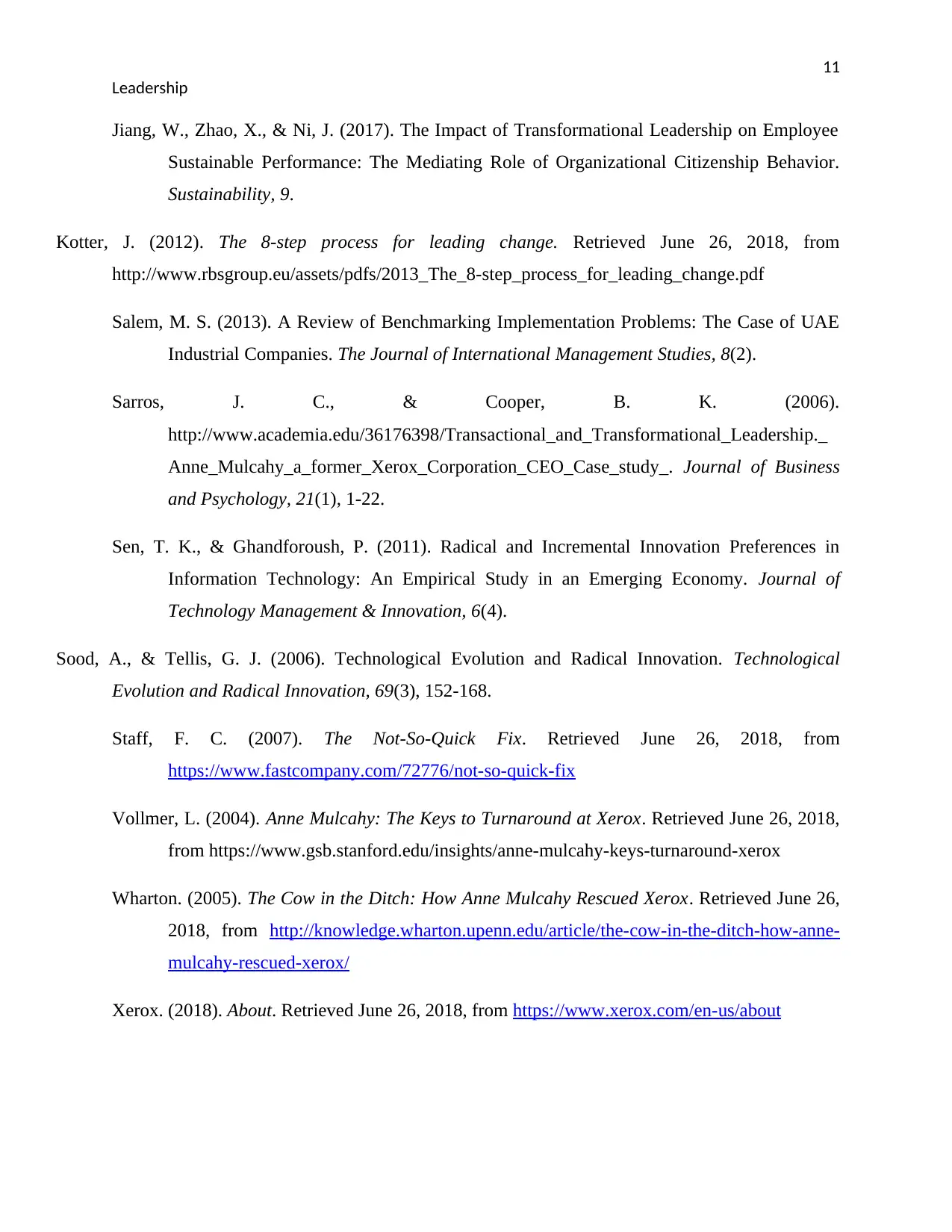
11
Leadership
Jiang, W., Zhao, X., & Ni, J. (2017). The Impact of Transformational Leadership on Employee
Sustainable Performance: The Mediating Role of Organizational Citizenship Behavior.
Sustainability, 9.
Kotter, J. (2012). The 8-step process for leading change. Retrieved June 26, 2018, from
http://www.rbsgroup.eu/assets/pdfs/2013_The_8-step_process_for_leading_change.pdf
Salem, M. S. (2013). A Review of Benchmarking Implementation Problems: The Case of UAE
Industrial Companies. The Journal of International Management Studies, 8(2).
Sarros, J. C., & Cooper, B. K. (2006).
http://www.academia.edu/36176398/Transactional_and_Transformational_Leadership._
Anne_Mulcahy_a_former_Xerox_Corporation_CEO_Case_study_. Journal of Business
and Psychology, 21(1), 1-22.
Sen, T. K., & Ghandforoush, P. (2011). Radical and Incremental Innovation Preferences in
Information Technology: An Empirical Study in an Emerging Economy. Journal of
Technology Management & Innovation, 6(4).
Sood, A., & Tellis, G. J. (2006). Technological Evolution and Radical Innovation. Technological
Evolution and Radical Innovation, 69(3), 152-168.
Staff, F. C. (2007). The Not-So-Quick Fix. Retrieved June 26, 2018, from
https://www.fastcompany.com/72776/not-so-quick-fix
Vollmer, L. (2004). Anne Mulcahy: The Keys to Turnaround at Xerox. Retrieved June 26, 2018,
from https://www.gsb.stanford.edu/insights/anne-mulcahy-keys-turnaround-xerox
Wharton. (2005). The Cow in the Ditch: How Anne Mulcahy Rescued Xerox. Retrieved June 26,
2018, from http://knowledge.wharton.upenn.edu/article/the-cow-in-the-ditch-how-anne-
mulcahy-rescued-xerox/
Xerox. (2018). About. Retrieved June 26, 2018, from https://www.xerox.com/en-us/about
Leadership
Jiang, W., Zhao, X., & Ni, J. (2017). The Impact of Transformational Leadership on Employee
Sustainable Performance: The Mediating Role of Organizational Citizenship Behavior.
Sustainability, 9.
Kotter, J. (2012). The 8-step process for leading change. Retrieved June 26, 2018, from
http://www.rbsgroup.eu/assets/pdfs/2013_The_8-step_process_for_leading_change.pdf
Salem, M. S. (2013). A Review of Benchmarking Implementation Problems: The Case of UAE
Industrial Companies. The Journal of International Management Studies, 8(2).
Sarros, J. C., & Cooper, B. K. (2006).
http://www.academia.edu/36176398/Transactional_and_Transformational_Leadership._
Anne_Mulcahy_a_former_Xerox_Corporation_CEO_Case_study_. Journal of Business
and Psychology, 21(1), 1-22.
Sen, T. K., & Ghandforoush, P. (2011). Radical and Incremental Innovation Preferences in
Information Technology: An Empirical Study in an Emerging Economy. Journal of
Technology Management & Innovation, 6(4).
Sood, A., & Tellis, G. J. (2006). Technological Evolution and Radical Innovation. Technological
Evolution and Radical Innovation, 69(3), 152-168.
Staff, F. C. (2007). The Not-So-Quick Fix. Retrieved June 26, 2018, from
https://www.fastcompany.com/72776/not-so-quick-fix
Vollmer, L. (2004). Anne Mulcahy: The Keys to Turnaround at Xerox. Retrieved June 26, 2018,
from https://www.gsb.stanford.edu/insights/anne-mulcahy-keys-turnaround-xerox
Wharton. (2005). The Cow in the Ditch: How Anne Mulcahy Rescued Xerox. Retrieved June 26,
2018, from http://knowledge.wharton.upenn.edu/article/the-cow-in-the-ditch-how-anne-
mulcahy-rescued-xerox/
Xerox. (2018). About. Retrieved June 26, 2018, from https://www.xerox.com/en-us/about
1 out of 12
Related Documents
Your All-in-One AI-Powered Toolkit for Academic Success.
+13062052269
info@desklib.com
Available 24*7 on WhatsApp / Email
![[object Object]](/_next/static/media/star-bottom.7253800d.svg)
Unlock your academic potential
© 2024 | Zucol Services PVT LTD | All rights reserved.





